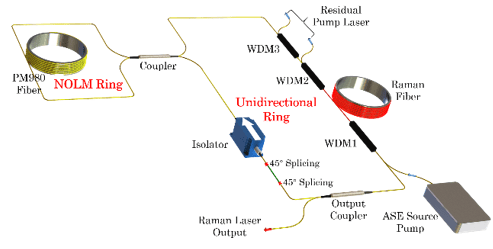Jul 18 2019
In the last few decades, ultrafast fiber lasers have gained increasing interest, thanks to their applications in biomedicine, fundamental research, and industry.
 Experimental setup of the laser system. (Image credit: SIOM)
Experimental setup of the laser system. (Image credit: SIOM)
When compared to rare-earth-doped ultrafast fiber lasers that can operate only in restricted spectral range, ultrafast Raman fiber lasers have a peculiar advantage of wavelength agility. However, their characteristics like pulse width, pulse energy, and pulse train stability are worse than their rare-earth-doped equivalents.
Among various types of pulse shaping mechanisms, dissipative soliton (DS) is a sound method that has the ability to enhance pulse stability and energy.
With regards to saturable absorbers, nonlinear optical loop mirror (NOLM) is a method well-matched with all polarization-maintaining (PM) fiber configurations and is capable of realizing enduring stable pulse operation.
More recently, a team of researchers from the Shanghai Institute of Optics and Fine Mechanics of the Chinese Academy of Sciences used a NOLM and developed a mode-locked Raman DS fiber laser. The associated research has been published in Optics Express.
Spectral filtering is an essential technique for pulse and spectral shaping in the DS mode-locking. Thus, the researchers used an all-fiber Lyot filter based on the birefringence and dispersion of PM fiber in their experiment for the purpose of a spectral filter.
In addition, a 1064-nm amplified spontaneous emission source was used as a pump source in mode-locked Raman fiber laser for the additional enhancement of pulse stability.
The researchers described that stable 1120-nm Raman DS pulses with typical DS features could be achieved at a repetition rate of 1.23 MHz with their experiment. The highest pulse energy was 1.23 nJ, and the lowest pulse width was 63 ps. The signal-to-noise ratio of the radio frequency spectrum of the Raman DS was as high as 85 dB.
Their experimental finding revealed that NOLM-based Raman DS ought to be a potential solution to produce wavelength-flexible linearly polarized pulses with high pulse stability. Hence, this study could offer a new method to achieve linearly polarized ultrafast laser at versatile wavelengths.
This study was funded by the National Natural Science Foundation of China and China Postdoctoral Science Foundation.
Source: http://english.cas.cn/